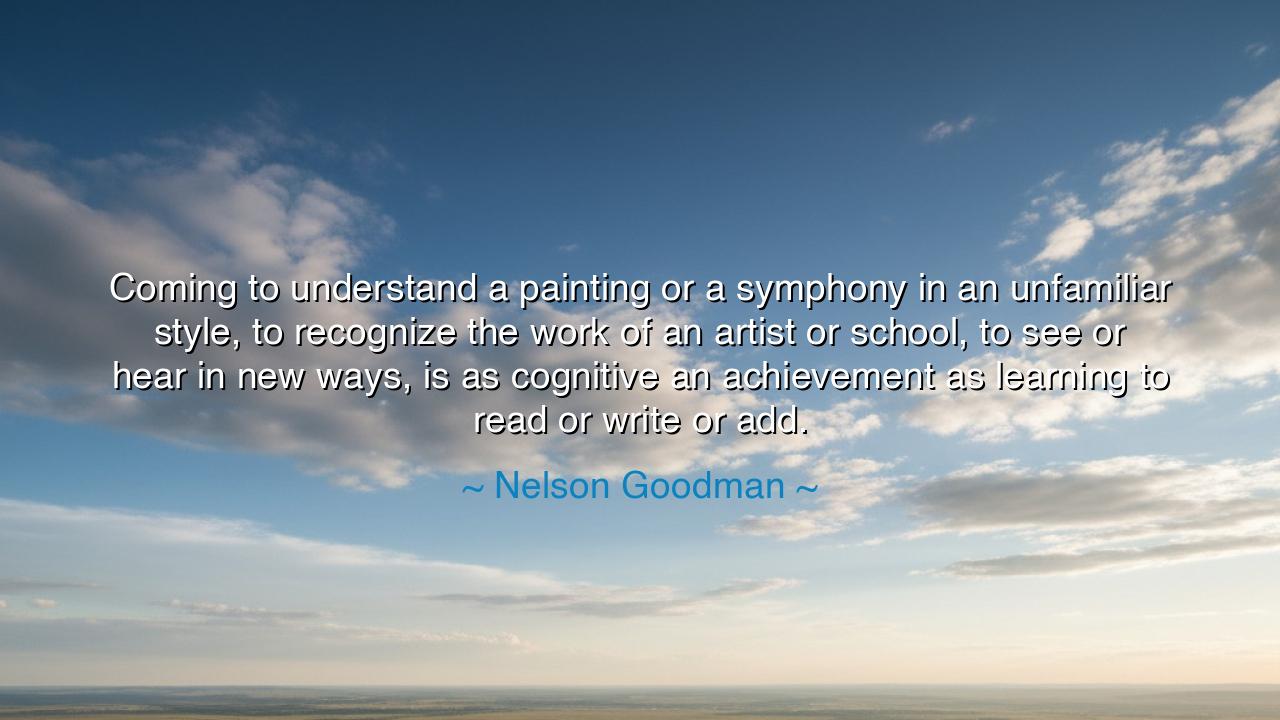
Coming to understand a painting or a symphony in an unfamiliar
Coming to understand a painting or a symphony in an unfamiliar style, to recognize the work of an artist or school, to see or hear in new ways, is as cognitive an achievement as learning to read or write or add.






In the profound words of Nelson Goodman, philosopher and scholar of art and mind, we are given a revelation of vision and intellect: “Coming to understand a painting or a symphony in an unfamiliar style, to recognize the work of an artist or school, to see or hear in new ways, is as cognitive an achievement as learning to read or write or add.” This is not a simple thought about art—it is a call to awaken our minds to the intelligence of perception, the deep mental power that lies not only in calculation, but in understanding beauty, in seeing beyond the surface of things. Goodman reminds us that to truly see or hear with comprehension is no less noble than to reason with numbers or words.
In the ancient world, the wise knew that learning did not end with the scroll or the tablet. To learn was to train the senses—to attune the eye to form, the ear to harmony, the soul to proportion. The Greeks called it paideia, the cultivation of the whole being, not merely the mind. For what is art but another language—a language of color, of rhythm, of silence and motion? To understand it requires the same discipline and devotion as any scholar’s craft. Thus, Goodman’s words speak of the cognitive act hidden within appreciation—the mind’s awakening through the senses, the union of intellect and emotion into one enlightened seeing.
Think of Leonardo da Vinci, the master who saw in the flutter of a bird’s wing the secret of flight, and in the curve of a smile the mystery of human thought. He did not separate science from art, nor reason from beauty. When he painted the Mona Lisa, he was performing both artistic and intellectual labor—studying the play of light upon flesh, the mathematics of proportion, the music of shadow and smile. To understand such a work is not to glance at its image, but to enter its language, to decipher its logic, to feel its silent reasoning. As Goodman teaches, this kind of seeing is a cognitive achievement, for it requires us to expand the limits of our understanding and embrace new forms of knowledge.
So too with music, that art which speaks directly to the soul without words. When one first hears a symphony by Beethoven, the mind may struggle to follow the storm of sound—the rise and fall, the patterns that seem chaotic yet hold order within. But when we learn to listen—not merely to hear, but to comprehend—we begin to perceive structure, theme, variation. In that moment, the act of listening becomes thought itself. The heart reasons, the intellect feels. It is as Goodman says: to perceive art rightly is to learn, just as surely as one learns to read or to reason with numbers. It is the education of perception.
But how many walk through galleries with eyes unseeing, or hear melodies with ears unhearing? The tragedy of our time is that we separate intellect from imagination, as if the mind and the spirit must dwell apart. Goodman’s insight restores their unity. He calls us to see and hear in new ways, to train our perception as we train our logic, to cultivate understanding not only in language, but in the subtle symphony of the world. The mind that learns to perceive beauty with intelligence grows vast and flexible; it becomes capable of perceiving truth in all its forms—scientific, emotional, spiritual, and aesthetic.
In this light, art becomes education, and the viewer becomes a student of existence. Just as one learns to decipher letters and meanings from the page, so too must one learn to read the grammar of form, color, rhythm, and silence. The child who learns to see the difference between light and shadow, between stillness and movement, learns the same kind of cognitive precision that the mathematician or philosopher seeks in symbols. Both are builders of understanding—one with words, the other with wonder.
And so, O listener, the lesson is this: Train your perception. Do not look upon art as decoration, nor upon music as mere sound. Approach them as languages of wisdom. Stand before a painting not to like or dislike, but to learn its speech, to let your mind be shaped by its structure. Listen to music not as background, but as a dialogue between the infinite and the human. To understand beauty is to expand your intellect, to see and hear as the universe does—completely, attentively, reverently.
In the end, the true scholar is one who reads with the eyes, the ears, and the heart alike. Goodman’s words remind us that wisdom is not confined to the written word, but lives also in sound, color, and form. To see in new ways is to think anew. To hear deeply is to awaken the mind. Let every act of perception be an act of learning, and you shall find that the world itself is a vast, luminous text—written in light, sound, and soul—for those who have learned to read it.






AAdministratorAdministrator
Welcome, honored guests. Please leave a comment, we will respond soon